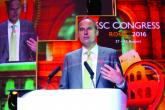Conference Coverage

Joint European atrial fibrillation guidelines break new ground
ROME – The novel oral anticoagulants are now strongly recommended over warfarin for stroke prevention.

ORLANDO – New European Society of Cardiology management guidelines encourage electrocardiogram screening for silent atrial fibrillation (AF) in high-risk patients, even if these guidelines do not fully spell out the specific definition of high risk, according to a guideline reviewer who summarized key points at the annual International AF Symposium.
“For the first time in any guideline, we now have a recommendation for systematic ECG screening of silent AF, particularly for patients older than age 75 years or those otherwise at high risk of stroke,” reported John Camm, MD, professor of clinical cardiology, St. George’s University, London.
However, the 2016 ESC guidelines do not outline specific screening steps for specific groups at high risk of silent AF, leaving the wording vague (Eur Heart J. 2016 Aug 27;37:2893-962). In fact, the guidelines may be better characterized as encouraging rather than recommending ECG screening for silent AF even if the text outlines a strong rationale. After citing evidence that silent AF “is common with severe consequences such as stroke and death,” the guidelines conclude that opportunistic ECG screening “seems cost effective in elderly populations.” In two cited studies, the yield was 2.3% and 1.4% using, respectively, ECG alone or pulse palpation followed by ECG for abnormal pulse readings.Moreover, the screening for silent AF proposed in the most recent ESC guidelines for high-risk individuals is opportunistic rather than systematic, meaning that screening should be performed in patients who are interacting with the health system for another reason, such as an annual flu vaccination. This can be problematic for paroxysmal AF, which is the most common form. Dr. Camm, who was the first author of the 2010 ESC AF guidelines (Europace. 2010 Oct;12[10]:1360-420), acknowledged this issue.
“The problem is that AF must be present at the time that the ECG is performed and we know that AF is often intermittent. The longer or the more frequently ECG is used, the more paroxysmal AF will be detected, but of course this increases the cost of detection,” Dr. Camm noted. The guidelines note that the technology of detecting paroxysmal AF is evolving and may soon include portable smartphone technology but cautioned that these have yet to be formally evaluated. The potential value of daily short-term recordings in high-risk populations is raised but not endorsed in the new AF guidelines.
“One simple way to screen for AF is pulse palpation, which is something we all learned in medical school, but that is rarely undertaken these days,” Dr. Camm observed.
The value of pulse palpation, which can be readily taught to motivated patients, is that it has a very high negative predictive value, according to Dr. Camm. He suggested that absence of any pulse abnormalities essentially rules out the presence of atrial fibrillation even though abnormalities, if present, can be generated by rhythm disturbances other than AF. Screening ECGs in patients with pulse abnormalities are required to confirm the AF diagnosis.
The rising rates of AF in the United States, United Kingdom, and many other parts of the world are incompletely understood, but the ESC guidelines imply that the efforts to prevent the associated risk of stroke will require better detection of silent AF, which represents up to 40% of these rhythm disturbances. There is, as yet, no high-level evidence with which to confirm that early detection of silent AF leads to altered management that improves outcomes, according to Dr. Camm, but he suggested that this is a logical expectation that is currently being explored with ongoing studies.
Citing the potential for sensors and software built into watches and phones to facilitate screening for silent AF, Dr. Camm indicated that this is a field that may evolve quickly. In the meantime, he concurred with ESC guidelines, advocating screening for silent AF in older patients and patients with risk factors for stroke or AF.
Dr. Camm reports financial relationships with Bayer, Biotronik, Boehringer Ingelheim, Bristol-Myers Squibb, Boston Scientific, Daiichi, Eli Lilly, Laguna, Mitsubishi, Medtronic, Menarini, Novartis, Richmond Pharmacology, St. Jude Medical, and Servier.

ROME – The novel oral anticoagulants are now strongly recommended over warfarin for stroke prevention.
